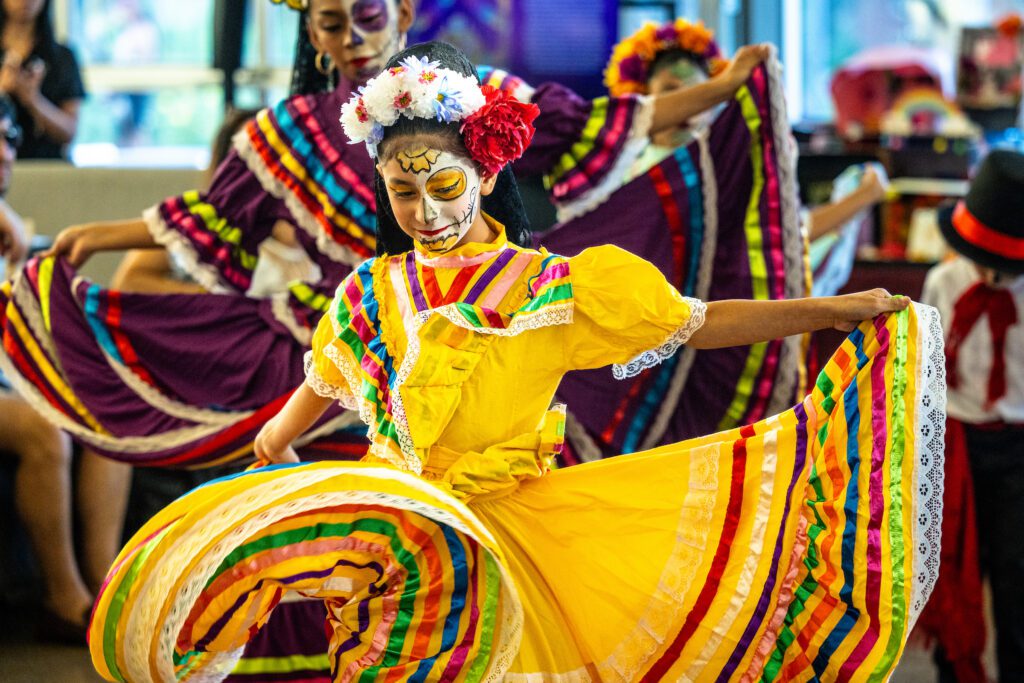Losing his father as a young man turned Mathew Sandoval’s pain into purpose — transforming death into his life’s work.
Now a teaching professor and Dean’s Fellow for Access and Inclusive Excellence at Barrett, The Honors College at Arizona State University, Sandoval has devoted his career to studying and celebrating Día de los Muertos, the Mexican tradition that commemorates the dead.
“This is how we honor our ancestors,” Sandoval said. “We believe that there’s medicine here. We invite everyone to participate in this process, which is difficult sometimes for people who are not a part of the culture and community to know how to deal with that.”
Día de los Muertos is celebrated every year on Nov. 1 and 2, coinciding with All Saints’ Day, but can last for weeks. While popular in Mexico, the holiday has grown in the United States, especially in border states like Arizona with sizable Hispanic populations. According to Sandoval, it has also caught on in states that do not have large Hispanic populations, like Maine and Iowa.
Traditions include setting up ofrendas, or altars, to honor lost loved ones. Bright marigold flowers, personal items and foods the departed enjoyed are typically displayed on the altars. Celebrations also feature colorful, large puppets called Mojigangas, carried in parades to remember loved ones.
The practice is rooted in ancient Aztec rituals that honored the dead, particularly the goddess Mictecacihuatl, the Lady of the Dead.
Sandoval grew up in Southern California. After losing his father, he found comfort in the vibrant, communal rituals of Día de los Muertos.
“The fact of the matter is, is that death is the one thing that unites us,” he said. “It doesn’t matter about culture, it doesn’t matter about race, religion — like, we’re all going to lose people. We all deeply grieve when we lose people, and that’s one of the things that can connect us.”
Attend an event
ASU is hosting a variety of Día de los Muertos celebrations this year. Learn more:
Polytechnic campus
4–7 p.m. Thursday, Oct. 30
Student Union
Barrett, The Honors College
5–7 p.m. Saturday, Nov. 1
Arizona Center, downtown Phoenix
Hispanic Research Center exhibition
Through Dec. 5
Interdisciplinary A, Tempe campus
Sandoval’s work encompasses years of research and education, including his books, “Día de los Muertos: A Chicano Arts Legacy” and “A Cultural History of Day of the Dead: How Día de los Muertos Became Mexican,” which received the Public Scholar Award from the National Endowment for the Humanities last year.
In addition to being one of NEH’s most competitive grants, the Public Scholar Award is part of a White House initiative to promote cross-cultural understanding. Sandoval is partnering with the Latino political research organization Equis and the arts and media company Amplifier to create an educational curriculum about Día de los Muertos for schools nationwide, with the aim to reach more than a million students.
At ASU, Sandoval organizes campus events and collaborates with artists, educators and community groups to build altars and host workshops on remembrance. Sandoval says these events foster belonging and pride among participants, helping many — Latino and non-Latino alike — connect with their own family histories.
His teaching encourages students to reflect on death and memory in their own lives.
“It’s about turning mourning into an act of love, not just for the dead but for the living,” he said. “I always tell my students, and the public, that it’s also always about remembering and honoring your ancestors who you may never have met.”
Sandoval’s outreach also extends beyond the university. Each year, he works with Valley organizations to expand Día de los Muertos programming through public altars, art exhibits and community discussions about loss and healing, and this year is no exception.
This year, the holiday has Sandoval reflecting on his own mortality because he’s balancing work with caring for his baby daughter, Alma — whose name means soul.
“When I pass, my daughter is going to make an ofrenda that’s worthy of the life that I live,” he said. “So, what kind of ancestor do I want to become?”
Creating an ofrenda
The ofrenda, or altar, is one of the traditional aspects of Day of the Dead. And there are a number of items that are usually included in these altars. Here, Teaching Professor Mathew Sandoval explains these elements.
Photos: “On a traditional ofrenda, you will always find photographs of the person who you’re honoring. And on most family ofrendas, that means you’re going to have a lot of photographs because very few ofrendas are just for one person. So you’re honoring your family line.”
Flowers: “The scent of the flowers is often considered one of the things that will draw the people from the spirit land back to the land of the living. So you want to have fresh flowers. Usually it’s the marigold flower or cempasúchil flower, which is indigenous to Mexico, that becomes a common flower on Day of the Dead ofrendas.”
Food and water: “The other thing that you’ll have is a lot of food and water, because yo, real talk, the trip from the land of the dead back to the land of the living is a long one. You’re going to need to be quenched with water. You’re going to be hungry at the end of that trip. So you gotta feed the spirits the things that they wanted, and usually you’ll put the things that they wanted.”
The four elements: “You’ll also have elements that represent the four natural elements — earth, wind, water and air. So the food meaning the earth; water obviously meaning water; the fire is represented through candles usually or copal incense. … And then wind is usually signified through papel picado or those paper banners that you see, which if you’re doing an outside ofrenda will catch the wind. And sometimes if you’re very sentimental like me, it’s always like a signal that the spirits are coming back.”

